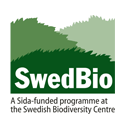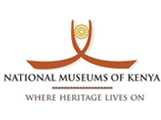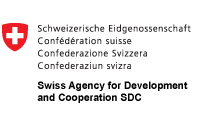Scientific Classification
Species in the Genus
Species in Kenya, Tanzania & Uganda
Description
Possible Causes of Confusion
Distribution in Kenya, Tanzania & Uganda
Habitats
Nesting
Crops Visited
Other Plants Visited
Economic / Ecological Importance
Threats
Conservation and Management Practices
Legislation (National and International)
References
Editors
Acknowledgements
Contact
Click on images to enlarge

Meliponula ferruginea. ©Nicolas Vereecken
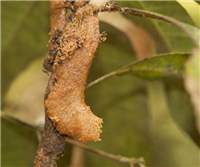
Meliponula ferruginea. ©Nicolas Vereecken
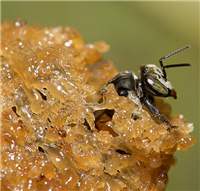
Meliponula ferruginea. ©Nicolas Vereecken
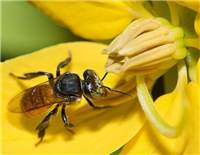
Meliponula ferruginea. ©Nicolas Vereecken
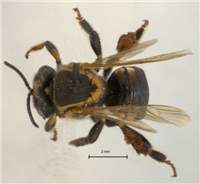
Meliponula beccarii (female) - pinned specimen. Photo: Connal Eardley
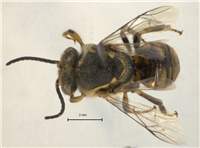
Meliponula beccarii (male) - pinned specimen. Photo: Connal Eardley
Summary
Honey bees are not the only bee species that are significant for human wellbeing. Meliponula bees (which like a number of groups of bees are known as stingless bees) are a group of native bee species that produce honey and store pollen which is harvestable. Their honey and pollen is widely harvested from the wild but in a destructive and non-sustainable manner. Meliponula bees are also important pollinators of crops and wild plants. Although they are widely known in East Africa, Meliponula bees are not thought to be bees by most local people. These smaller to medium sized bees do not sting. They nest in colonies both in the ground and in woody material. This fact sheet provides information about these bees to encourage farmers to understand and protect them to help ensure that their crops are effectively pollinated.
From a conservation and agricultural standpoint it is not necessary to recognise all the different bee genera. However, it is important to know that there is a large bee biodiversity. Different bee genera pollinate different plant species, although there is some overlap that acts as a buffer as bee populations wax and wane. For healthy ecosystems, including agro-ecosystems both diversity and abundance in the bee fauna is important.
Common Name (Language)
Stingless bees (English); Maranga, Obwiza, Obugashu, Obuzagali, Obuganza (Abayanda or pygmy language of Uganda), Obuhura (Rukiga - Uganda), Ebihura (Kinyarwanda-Uganda); Ngilû and Mbûa, Kadoma (Luganda, Uganda) (Kamba and other communities – Kenya).
Scientific Classification
Kingdom: Animalia
Phylum: Arthropoda
Class: Insecta
Order: Hymenoptera
Family: Apidae
Subfamily: Apinae
Tribe: Meliponini
Genus: Meliponula Cockerell, 1934
Species in the Genus
Stingless bees are a large and diverse group comprising over 600 species in 56 named genera. However, there are only about 22 species in
Species in Kenya, Tanzania & Uganda
Meliponula bees are among the best known taxonomically of the Meliponini bee species occurring in
Description
Meliponula bees belong to the tribe Meliponini (stingless bees) which along with the honey bee (which belong to the tribe Apini) constitute the two highly eusocial bee groups. i.e. bees that live in large colonies of individuals in which there is a division of labour including reproductive queens and sterile workers.
Although these insects are well known to farmers they are generally not recognised as bees, as the name bee is generally thought only to apply to honey bees.
Meliponula bees are important pollinators in sub-Saharan Africa. In common with many eusocial bee groups and the mostly solitary orchid bees (Euglossini) they have a corbicula (or pollen basket), a pollen-carrying structure on the hind legs that is modified from the common brush of hairs.
Possible Causes of Confusion
Some insect species look like large Meliponula bees. These include other stingless bees in the genus Plebeina. Plebeina bees are mostly smaller than Meliponula bees. Some hoverflies can resemble Meliponula bees like Meliponula bocandei. Flies can be distinguished from Meliponula bees as they have only two wings while bees have four wings.
Distribution in Kenya, Tanzania & Uganda
The genus Meliponula is found in most districts/regions of
Habitats
Meliponula bees are well distributed in tropical Africa and can be found in various specific habitats (land-uses) in East Africa such as grasslands, natural forests, wetlands, marshlands, protected areas, farmlands, woodlands, woodlots (forest plantations) and riparian forest areas.
Nesting
Meliponula bees use various structures in the nature for nesting. These are social bees that nest both in the soils and in wooden materials (Michener 2007, Eardley 2005). In
Crops Visited
Meliponula bees are likely to be among the most effective crop pollinators in East Africa. These bees collect nectar and pollen from various flowering crop species belonging to a large number of plant families found in
Other Plants Visited
In
Economic / Ecological Importance
Meliponula bees are of high economic importance as providers of pollination services that contribute to increased agricultural productivity and the conservation of the natural biological diversity of the region. They also contribute hive products. Improved management holds the promise for increased economic benefit from Meliponula bees.
Threats
In
Conservation and Management Practices
Stingless bees play an important ecological role as pollinators of many wild plant species and seem good candidates for future alternatives in commercial pollination (Slaa et al, 2006). Stingless bees can pollinate most cultivated crops; therefore, their presence nearby fields can be very beneficial to farmers. It is therefore important to manage habitats to conserve these bees.
There have been some attempts in domesticating stingless bees in
Legislation (National and International)
There is not yet any legislation in
References
1. Byarugaba D (2004) Stingless bees (Hymenoptera: Apidae) of Bwindi impenetrable forest,
2. Cortopassi-Laurino M., Imperatriz-Fonseca VL, Rouik DV, Dollin A, Heard T, Aguilard I, Venturieri CG, Eardley C and Nogueira-Neto P (2006) Global meliponi culture: challenges and opportunities. Apidologie, 37:275–292
3. Eardley CD (2005) Taxonomic revision of the African stingless bees (Apoidea: Apidae: Apinae: Meliponini), African Plant Protection, 10:64–74
4. Eardley CD, M Gikungu and M.P Schwarz (2009) Bee conservation in Sub-Saharan Africa and
5. Eardley CD, Kuhlmann M and Pauly A. (2010) The Bee Genera and Subgenera of sub-Saharan
6. Eardley CD and R Urban (2010). Catalogue of Afrotropical bees (Hymenoptera: Apoidea: Apiformes). Zootaxa, 2455: 1–548.
7. Kajobe R (2008) Foraging behaviour of equatorial Afro-tropical stingless bees: Habitat selection and competition for resources. PhD thesis, University of Utrecht, Netherlands, 128pp.
8. Michener CD (2007) The Bees of the world, the John Hopkins University Press,
9. Slaa EJ, Chaves LAS,
10. Rasmussen C and Cameron SA (2010) Global stingless bee phylogeny supports ancient divergence, vicariance, and long distance dispersal. Biological Journal of the Linnean Society, 99: 206–232.
Editors
Théodore Munyuli, Busitema University - Uganda; Muo Kasina, Kenya Agricultural Research Institute (KARI) - Kenya; Juma Lossini, Tropical Pesticides Research Institute (TPRI) – Tanzania; John Mauremootoo, BioNET-INTERNATIONAL Secretariat – UK; Connal Eardley, Plant Protection Research Institute (PPRI) – South Africa.
Acknowledgements
We recognise the support from the Kenya Agricultural Research Institute (KARI), Tropical Pesticide Research Institute (TPRI) –
Contact
BioNET-EAFRINET regional coordinator: [email protected]





